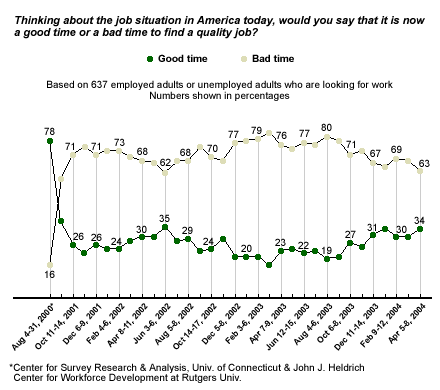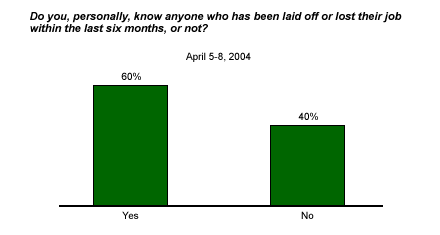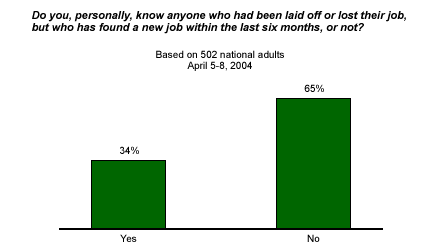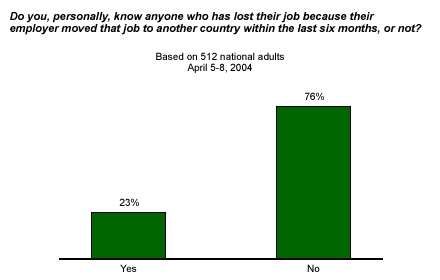On April 8, Federal Reserve Board Vice Chairman Roger W. Ferguson Jr. put the stunning March jobs report into perspective: "As has been widely recognized, one notable shortcoming of the current expansion has been the dearth of job creation over the past two years. Last week's report that employers added 308,000 workers to their payrolls in March was encouraging and may signal that the recovery in the labor market is gaining traction. Even so, the level of private employment remains more than 500,000 -- or ½ percent -- below that at the trough of the recession in November 2001."
New Gallup Poll economic data (April 5-8)* show that Americans hold similar views of today's job market. Although the percentage of Americans employed, or unemployed and looking for work, who think this is a bad time to find a quality job remains high, it is also at its lowest level in nearly two years. And while the percentage of people who say they know someone who has been laid off or lost his or her job within the last six months also remains high, one in three Americans know someone who has lost his or her job but found a new one within the past six months.
Does the March improvement in job creation, combined with the lessening job market pessimism in April, mean we can remove the "jobless" appellation when referring to the current economic recovery? More importantly, how might perceptions that the job market is improving affect interest rates when the Federal Open Market Committee (FOMC) holds its May 4 meeting?
Less Pessimism About Jobs
Sixty-three percent of Americans who are employed or looking for work feel that now is a bad time to find a quality job. Although far from a positive reading on current job market conditions, this is the second-lowest level of job market pessimism since August 2001. Further, one in three respondents (34%) say now is a good time to find a quality job.

Some People Are Finding New Jobs
Six in 10 Americans (60%) say they personally know someone who has been laid off or lost a job within the last six months. Twenty-three percent know someone who has lost his or her job because the employer moved that job to another country within the past six months. On the other hand, 34% know someone who has lost a job, but also found a new job within the last six months.



Job Insecurity
Federal Reserve Board Chairman Alan Greenspan noted in his March 11 testimony before the House Committee on Education and the Workforce, "Job insecurity is understandably significant when nearly 2 million members of our workforce have been unemployed for more than six months." Ferguson adds historical context this way, "… it is even weaker than during the infamous ‘jobless recovery' of the early 1990s. For example, employment rose about 2% in the 28 months following the 1990-1991 recession. And, in the other seven post-World War II recoveries, employment growth averaged more than 8% over a period of comparable length."
From their recent speeches, it seems clear that the governors of the Fed recognize that the surprising March job numbers have not ended the joblessness plaguing the current recovery. Gallup's data suggest that the public agrees, as perceptions of the job market remain extremely negative -- although less pessimistic than they have been for some time.
Bottom Line
Barring an unexpected surge in job creation over the next several months -- something in the range of 300,000 to 500,000 new jobs per month -- this recovery will remain "jobless," and the outsourcing of jobs to other countries will continue to be a hot political issue. As a result, I think the FOMC will continue to do what it can to ameliorate the job market situation by keeping interest rates low in the months ahead, even at the cost of some added inflation. To do otherwise would be to risk being blamed for the continued weakness of the job market during a presidential election campaign, something an independent Fed does not want.
*Results are based on telephone interviews with 1,014 national adults, aged 18 and older, conducted April 5-8, 2004, and telephone interviews with 637 adults employed full or part time or unemployed adults looking for work. For results based on the total sample of national adults, one can say with 95% confidence that the margin of sampling error is ±3 percentage points and for results based on those working or looking for work, one can say with 95% confidence that the margin of sampling error is ±4 percentage points.

